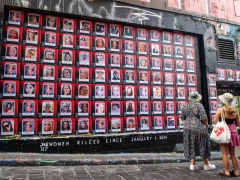Melbourne, Australia – Lee Little recalls the phone call with her daughter in December 2017; it was just minutes before Alicia was killed.
“I spoke to her 15 minutes before she died,” Little told Al Jazeera.
“I asked her, was she OK? Did you want us to come up to pick you up? And she said, ‘No, I’ve got my car. I’m right, Mum, everything’s packed.’”
Alicia Little was on the verge of finally leaving an abusive four-and-a-half-year relationship.
Not only had Alicia rung her mother, but she had also called the police emergency hotline for assistance, as her fiance Charles Evans fell into a drunken rage.
Alicia knew what to expect from her partner: extreme violence.
Evans had a history of abuse towards Alicia, with her mother recounting to Al Jazeera the first time it occurred.
“The first time he actually bashed her, she was on the phone to me. And the next minute, I heard him come across and try to grab her phone,” Little said.
“I heard her say, ‘Get your hands off my throat. I can’t breathe.’ And the next minute, you hear him say, ‘You’re better off dead.’”
Little told how she had taken photos of her daughter’s terrible injuries.
“She had broken ribs. She had a broken cheekbone, broken jaw, black eyes, and where he’d had her around the throat, you could see his finger marks. It was a bruise, and where he’d give her a kick, and right down the side, you could see his foot marks.”
Like many abusive relationships, a pattern would emerge, whereby Alicia would leave temporarily, only to return after Evans promised to change his behaviour.
“This went on and off for the four and a half years,” Little said.
“He’d bash her, she’d come home, and then she’d say to me, ‘Mum, he’s told me that he’s gone and got help.’”
Yet the violence only escalated.
![Lee Little with a photograph of her daughter Alicia Little, who was killed by her partner after being driven into by a four-wheel-drive vehicle. Alicia's killer would serve only two years and 8 months jail for the crime [Ali MC/Al Jazeera]](http://www.aljazeera.com/wp-content/uploads/2025/08/Stop-Killing-Women-1-1756363322.jpg?w=770&resize=770%2C512&quality=80)
On the night Alicia decided to leave for good, Evans drove his four-wheel-drive at her, pinning her between the front of the vehicle and a water tank.
Alicia Little, aged 41 and a mother of two boys, died within minutes before the police she had called could arrive.
As she lay drawing her final breaths, security camera footage would later show her killer drinking beer at the local pub, where he drove to after running Alicia down.
Evans was arrested, and after initially being charged with murder, had his charges downgraded to dangerous driving causing death and failing to render assistance after a motor vehicle accident.
He would walk free from jail after only two years and eight months.
The statistics
Alicia Little is just one of the many women in Australia killed every year, in what activists such as The Red Heart Campaign’s Sherele Moody are saying is so prevalent that it amounts to a “femicide”: the targeted killing of women by men.
According to government data, one woman was killed in Australia every eight days on average between 2023-2024.
Moody, who documents the killings, contests those statistics, telling Al Jazeera they do not represent the true scale of deadly attacks on women in the country.
Government data records “domestic homicide”; women killed resulting in a conviction of murder or manslaughter.
As in the case of Alicia Little, the lesser charges her killer was convicted on related to motoring offences and do not amount to a domestic homicide under government reporting and are not reflected in the statistics.
“One of the key weapons that perpetrators use against women in Australia is vehicles,” Moody told Al Jazeera.
“They almost always get charged with dangerous driving, causing death. That is not a homicide charge. It doesn’t get counted despite it being a domestic violence act, an act of domestic violence perpetrated by a partner,” Moody said.
“The government underrepresents the epidemic of violence. And in the end, the numbers that they’re using influence their policy. It influences their funding decisions. It influences how they speak to us as a community about violence against women,” she said.
Moody said that between January 2024 and June this year, she had documented 136 killings of women; many – like Alicia Little – by their partners. “Ninety-six percent of the deaths I record are perpetrated by men.”
“Around 60 percent of the deaths are the result of domestic and family violence,” she said.
![Sherele Moody, from the Red Heart campaign, speaks with the media at a Stop Killing Women protest earlier this year in Melbourne, Australia. Moody says the official government data under-represents the true scale of femicide in Australia [Ali MC/Al Jazeera]](http://www.aljazeera.com/wp-content/uploads/2025/08/Stop-Killing-Women-03-1756363768.jpg?w=770&resize=770%2C512&quality=80)
While much focus is on women’s safety in public spaces – for example, walking home alone at night – Moody said the least safe place for a woman is actually in her own home.
“The reality is that if you’re going to be killed, whether you’re a man or woman or a child, you’re going to be killed by someone you know,” she said.
Data shows that only about 10 percent of female victims are killed by strangers, deaths often sensationally covered by the media and prompting public debate about women’s safety.
“Yes, stranger killings do happen, and when they do, they get a lot of focus and a lot of attention, and it lulls people into a false sense of security about who is perpetrating the violence,” Moody said.
Male violence in Australia
Patty Kinnersly, CEO of Our Watch, a national task force to prevent violence against women, said attacks on women are the “most extreme outcome of broader patterns of gendered violence and inequality”.
“When we refer to the gendered drivers of violence, we are talking about the social conditions and power imbalances that create the environment where this violence occurs,” Kinnersly said.
“These include condoning or excusing violence against women, men’s control of decision-making, rigid gender stereotypes and dominant forms of masculinity, and male peer relations that promote aggression and disrespect towards women,” she said.
“Addressing the gendered drivers is vital because violence against women is not random; it reflects deeply entrenched inequalities and norms in society. If we do not address these root causes, we cannot achieve long-term prevention,” she added.
Patterns of male violence are deeply rooted in Australia’s colonial history, in which men are told they need to be physically and mentally tough, normalising male aggression, write authors Alana Piper and Ana Stevenson.
“For much of the 19th century, men far outnumbered women within the European population of the Australian colonies. This produced a culture that prized hyper-masculinity as a national ideal,” they write.
Colonial male aggression also resulted in extreme violence perpetrated on Indigenous women during the frontier times, through rape and massacres.
Misogyny and racism were also promoted in Australia’s parliament during the 20th century, as legislators crafted assimilationist laws aimed at controlling the lives of Indigenous women and removing their children as part of what has become known as the “Stolen Generations”.
Up to a third of Indigenous children were removed from their families as part of a suite of government policies between 1910 and 1970, resulting in widespread cultural genocide and intergenerational social, economic and health disparities.
This legacy of colonial racism and





